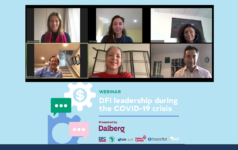Dalberg uses cookies and related technologies to improve the way the site functions. A cookie is a text file that is stored on your device. We use these text files for functionality such as to analyze our traffic or to personalize content. You can easily control how we use cookies on your device by adjusting the settings below, and you may also change those settings at any time by visiting our privacy policy page.
The world’s largest Development Impact Bond (DIB) for education has driven significantly improved learning outcomes for school children in its first two years. Its “pay for success” funding structure could pave the way for scaling education models post-Covid-19, and increase the life prospects for hundreds of thousands of disadvantaged children in India.
The “pay for success” funding mechanism launched in 2018 has significantly improved learning outcomes for over 100,000 primary school children in India. Children enrolled in programs funded by the US$11 million Quality Education India Development Impact Bond (QEI-DIB) have learned twice as fast as their peers without access to these programs.
This impact has been enabled by a partnership across the DIB risk investor, outcome funders and four service providers, all leading local NGOs and social enterprises in the education sector in India, namely: Gyan Shala, Kaivalya Education Foundation, Pratham Infotech Foundation (PIF) collaborating with Educational Initiatives (EI), and Society for All Round Development (SARD). It is supported by Dalberg as outcome evaluator and performance manager.
The results are especially welcome given that new approaches to education are needed more than ever in India. According to a 2018 Annual Status of Education (ASER) survey, primary school children in government schools in India are typically at least two grades behind expected learning levels for their age group. The QEI-DIB was launched to close this gap, and over its four year timeline, will target 200,000 1st-8th grade children in four states by helping them “‘catch-up” to age-appropriate learning levels in language and mathematics.
Programs with impact that deliver strong education outcomes
Service providers run a range of interventions including training for teachers and school administrators, privately operated free schools in low income areas with high rates of out-of-school children, remedial classes for children who are behind, and an adaptive learning Edtech platform.
Interviews with students illustrate how these programs work in practice. Dinesh, a 5th grade student and beneficiary from Uttar Pradesh, had seen a computer only once before and had never had the chance to use one. He is now participating in the EdTech program run by PIF-EI, and says, “It is now much easier for me to learn.” Teachers also report that the EdTech software is an engaging way for children to learn. Pratiksha, a government school teacher says, “It feels like our students are truly learning. These children come from difficult backgrounds and it has always been our focus to find ways for them to do well.”
The private education program, Gyan Shala, empowers young women from neighbouring slums by providing them with basic teaching skills and methods to drive student learning outcomes. Interviews suggest these women feel supported by their teaching supervisors on how to navigate difficult teaching concepts or how to support the weakest learners in the classroom. They also report that they have gained respect and credibility in their communities.
The “pay for success” funding model
The DIB’s results-based funding mechanism makes this success possible, providing conditional financing for education service providers if specific development outcomes are achieved. Outcomes are agreed upfront and independently measured and verified each year. If the program successfully meets or exceeds its targets, the risk investor in the DIB earns a return which is paid by outcome funders. If outcomes are not met, the investor loses money.
With greater emphasis on outcomes instead of inputs, DIBs heighten the service providers’ focus on education outcomes, and fosters innovation around the most effective ways to meet these outcomes. For example, when Kaivalya Education Foundation noticed disparities in its students’ learning levels across schools in Mumbai, it modified the nature of its activities in Hindi-medium versus English-medium schools, catering to varied student needs resulting from language differences. Similarly, with the PIF-EI partnership, ‘gamification’ elements (e.g. virtual ‘awards’ and leaderboards) were created to incentivize children to use the EdTech platform more and with greater efficacy. In the same way, Gyan Shala experimented with apps that track attendance and engaged community members (including children’s classmates) to boost attendance when migration resulted in absenteeism. By contrast, funding that is tied to activities can lack flexibility when it comes to making changes around initial plans.
Because it is in every stakeholder’s interest to provide quality learning outcomes, DIBs lay the ground for high impact for development outcomes. Education service providers receive flexible working capital upfront, and can orient towards driving outcomes, with their reputations at stake for achieving success. The investor has real money at stake to lose or gain depending on the outcomes, and for the outcome funders: the model ensures efficient use of their capital, in that they only pay for actual impact on the ground .
Data and systems sharing enable nimble decision making
Given the DIB’s orientation towards outcomes, high performance hinges on there being a strong and consistent performance management framework and systems to help improve the program. A unique element of the DIB is that it often provides continued capacity-building and strategic problem solving support for service providers, which would not be available in most grant programs. Dalberg has served in this role from the start of the QEI-DIB.
Evaluation and performance management data are aligned and tracked, enabling education service providers to be agile, using real-time data for effective decision making, such as customizing programs in the field and course correcting where gaps emerge in order to achieve outcomes. Data and systems are what enable providers to scale while delivering high-quality outcomes.
Dalberg’s performance management framework aligns interests with the investor and service providers, providing the former with inputs on its portfolio via a hands-on localized understanding of program ecosystems, and the latter with strategic program management and cross-sharing of learnings from the broader DIB consortium. Overall, in keeping with the DIB model, Dalberg must ensure the capital deployed is being used towards executing the quality interventions required to meet the targets by the end of each year. So far overall, the impact bond has achieved three times its target in terms of learning gains for students.
Making a difference to the lives of many – and more – amid Covid-19
As the DIB entered its third year, Covid-19 was forcing school closures, disrupting the operations of key partners, and shifting priorities to remote learning and testing of new educational models. Service providers are now experimenting with driving learning via WhatsApp, SMS, TV programming etc., and where possible, augmenting these activities with call check-ins, socially-distanced learning through community volunteers, and teacher home visits. Dalberg is working closely with service providers to ensure the focus towards learning continues in these difficult circumstances.
Given the remarkable results accomplished to date, the QEI-DIB hopes to continue to achieve learning gains and deepen insights into new models that will live on. The pioneering “pay for success” funding model with its focus on outcomes, has so far enabled a group of high-impact service providers to reach ambitious goals, and bolstered their efforts through effective performance management. It is a valuable step away from activities-based funding, incentivizing innovation and agility at a critical time.
When the QEI-DIB ends in 2022, it could well offer a scalable and replicable education model for funding and driving outcomes efficiently across India’s primary schools, thus improving the prospects for India’s children.







